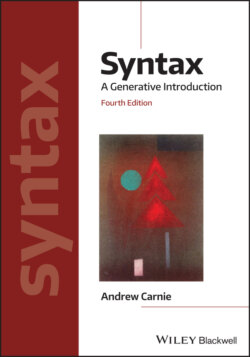Читать книгу Syntax - Andrew Carnie - Страница 29
Notes
Оглавление1 1. The notion that science should be the primary means of investigating linguistics has come under significant criticism by some members of indigenous communities (see for example, the opinions expressed by community members as reported in Czaykowska-Higgins 2009, the articles in Bischoff and Jany et al. 2019 and Rosborough, et al. 2017). The central idea is that by exclusively using a deductive scientific methodology in investigating their languages we are prioritizing a western European set of values on their traditions and cultures. When we as linguists work with native communities on their languages it is important that we acknowledge this perspective and think carefully about ways that our research can complement, connect to and support indigenous ways of knowing. We must also find ways in which we can be partners with these communities to help further their local agendas rather just observing their communities as objects of study and imposing our ideas upon them.
2 2. This is a bit of an oversimplification. We really have a “chicken and the egg” problem here. You can’t know what data to study unless you have a hypothesis about what is important, and you can’t have a hypothesis unless you have some basic understanding of the data. Fortunately, as working syntacticians this philosophical conundrum is often irrelevant, as we can just jump feet- first into both the hypothesis-forming and the data-analysis at the same time.
3 3. http://heideas.blogspot.com/2005/10/scalar-adjectives-with-arguments.html.
4 4. Whether language constrains what abstract things we can think about (this idea is called the Sapir– Whorf hypothesis) is a matter of great debate and one that lies outside the domain of syntax per se.
5 5. Along with psychology, neuroscience, communication, philosophy, and computer science.
6 6. http://www.wiley.com/go/carnie.
7 7. The working memory hypothesis is suspicious because speakers of languages like Japanese and German can understand the similar sentences in their languages without problem.
8 8. For an accessible discussion of the notions of i-language/e-language, competence/performance and langue/parole, see Duffield (2018).
9 9. The task is actually several magnitudes more difficult than this, as the child has to work out the phonology, etc., too, but for argument’s sake, let’s stick with this simplified example.
10 10. Note that this is the job of the child who is using Universal Grammar, not the job of UG itself.
11 11. The phenomenon in (28) is sometimes called the that-trace effect. There is no disputing the fact that this phenomenon is not learnable. However, it is also a fact that it is not a universal property of all languages. For example, French and Irish don’t seem to have the that-trace effect. Here is a challenge for those of you who like to do logic puzzles: If the that-trace effect is not learnable and thus must be biologically built in, how is it possible for a speaker of French or Irish to violate it? Think carefully about what kind of input a child might have to have in order to learn an “exception” to a built-in principle. This is a hard problem, but there is a solution. It may become clearer below when we discuss parameters.
12 12. Creole languages are new languages that are formed when a generation of speakers starts using a trade language or pidgin as their first language and speak it natively in the home.
13 13. This is a matter of some debate. Derbyshire (1985) has claimed that the language Hixkaryana has object-initial order.
14 14. http://itre.cis.upenn.edu/~myl/languagelog/archives/000901.html.
15 15. To be entirely accurate, (d) and (e) aren’t wholly ill-formed; they just can’t mean what (g) does. (d) can mean “I expect something else too, not just to double my profits” and (e) can mean “I expect to double something else too, not just my profits.” The * marks of ungrammaticality are for the intended reading identical to that of (g).
16 16. Many thanks to my Facebook posse for very helpful feedback on this problem set, including Emily Bender, Claire Bowern, Elizabeth Cowper, Joe Dupris, Megan Figueroa, Andrew Garrett, Jason Merchant, Tel Monks, and Dana Sussman.
17 17. There are of course people who have the physical characteristics of both sexes. This can be either by choice or due to their genetics. There are also people who were assigned an inaccurate or arbitrary sex at birth.
18 18. The Wikipedia page on gender (https://en.wikipedia.org/wiki/Gender; accessed Jan 12, 2018) has a fairly nuanced description of these distinctions as well as links to major academic sources on the distinction.
19 19. There are other related identities – including gender non-conforming, gender-queer, and gender- fluid. This isn’t a book about gender, so I’m going to pretend that these all fit neatly under the term “non-binary”, with the recognition that this is a gross oversimplification that doesn’t recognize the complexity and nuance that many people have about their gender identity. Please forgive the simplification.
20 20. For more on the phenomena discussed here, see Bjorkman (2017) and Konnelly and Cowper (2016).
21 21. http://itre.cis.upenn.edu/~myl/languagelog/archives/002180.html.
22 22. Thanks to Ahmad Lotfi for suggesting this part of the question.
23 23. This problem set was inspired by a discussion on a Facebook post by Gary Thoms.
24 24. This problem set is thanks to Matt Pearson.
25 25. The intended meaning for (iii) and (iv) is “Who is the person such that it is obvious that Tasha likes that person?” or “It’s obvious that Tasha likes somebody. Who is that somebody?”.
